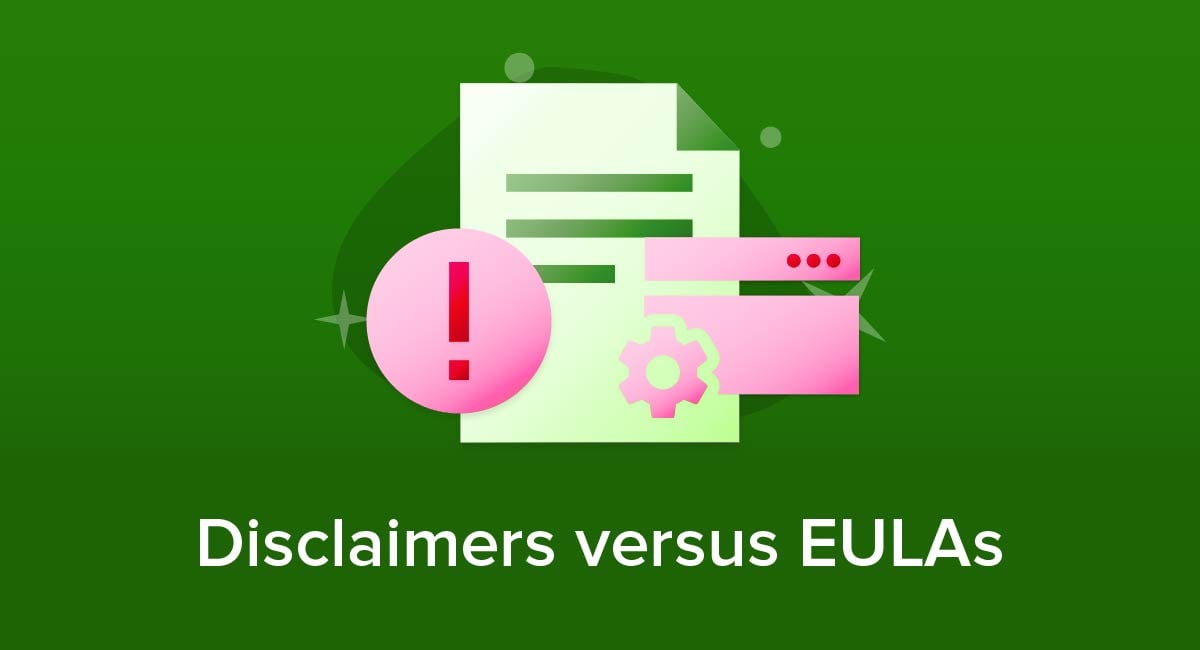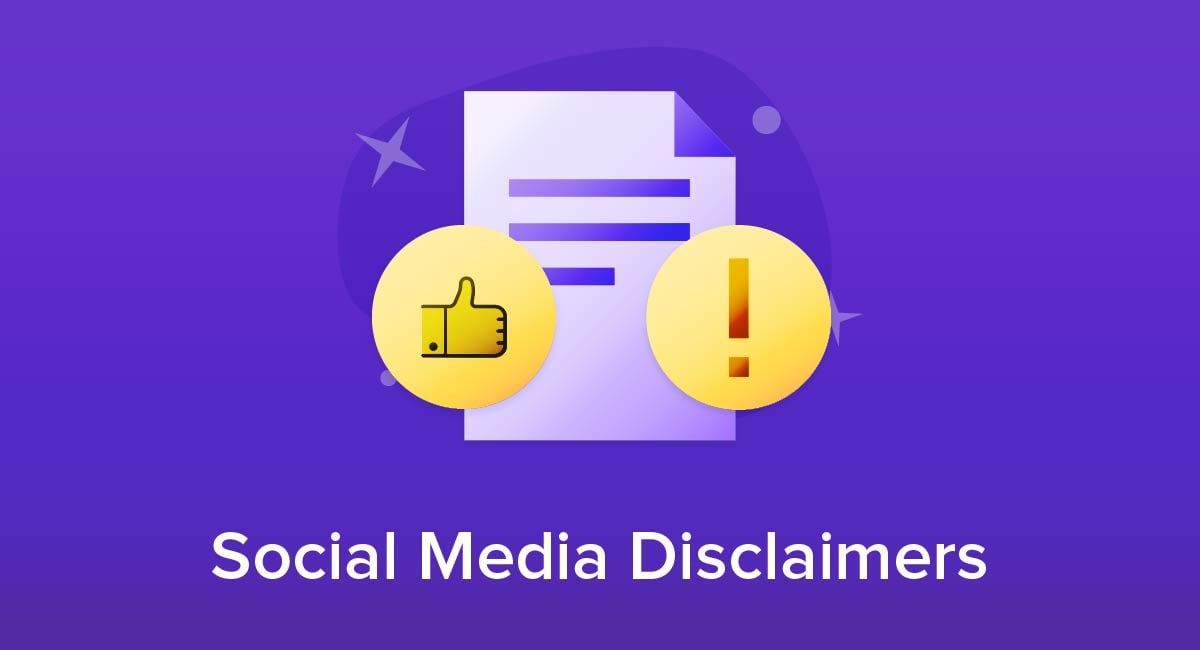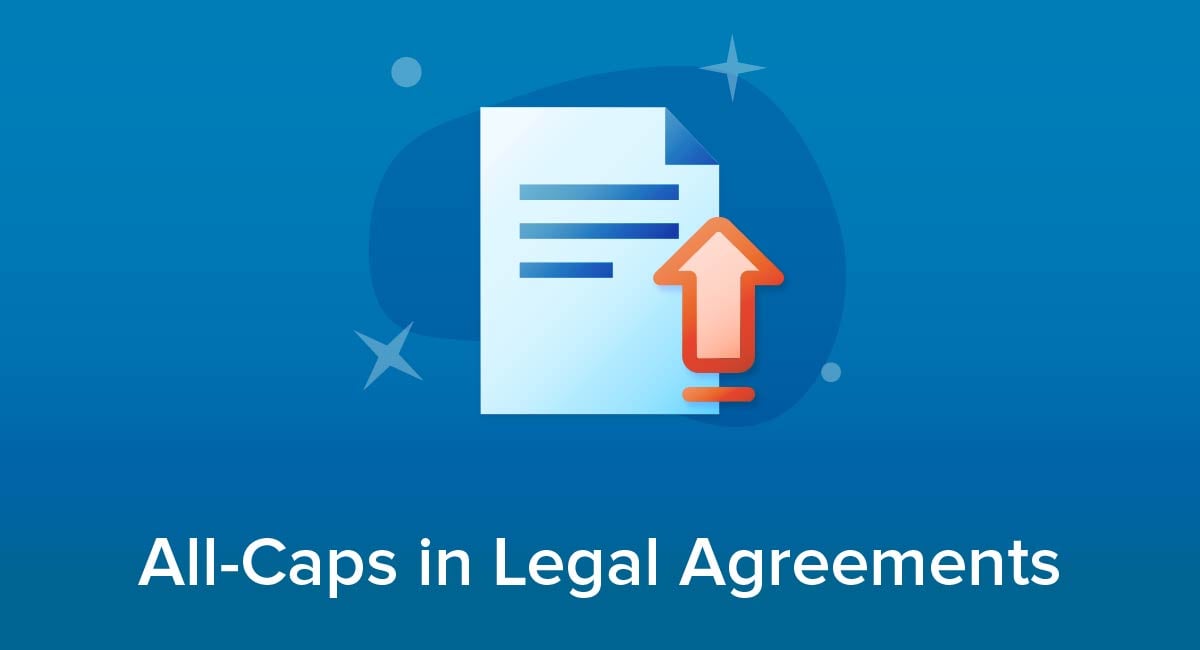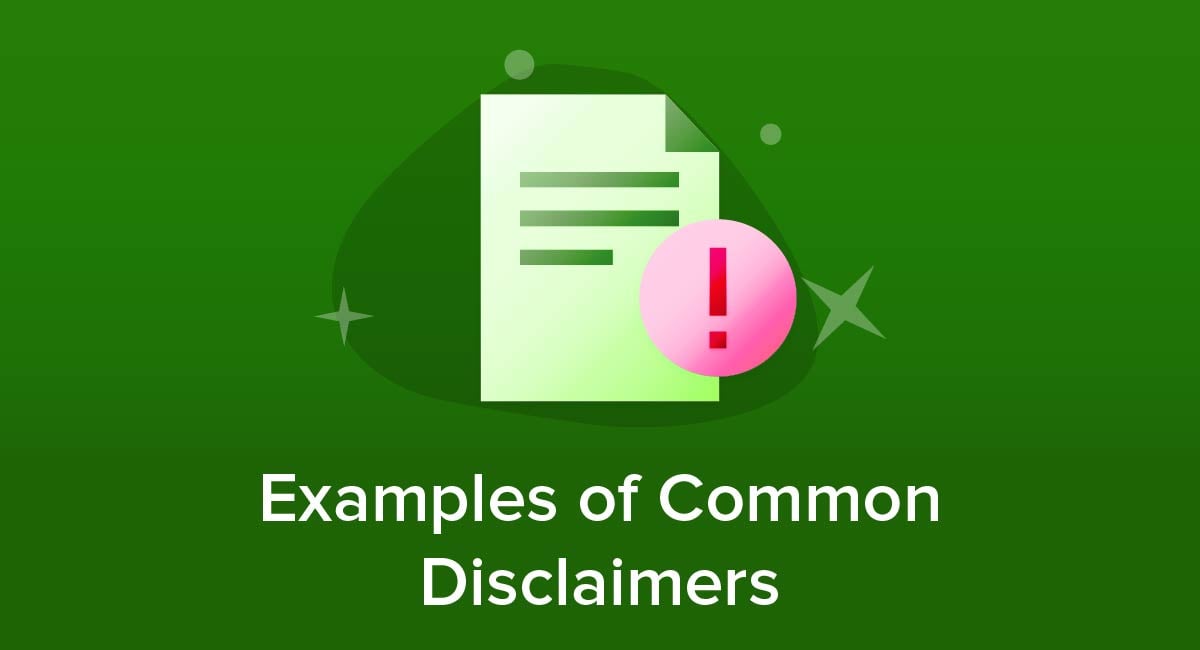
Disclaimers are statements that address your liability in specific cases that often aren't addressed in your primary Terms & Conditions or Privacy Policy.
These statements can be used to offset liability from your business to your client in troublesome or ambiguous legal areas or in cases where disclaimers are required by law.
We've put together a list of the most common disclaimers used on websites and apps. We've also pulled examples of these disclaimers that we feel are done particularly well so you can be inspired to create your own with our guidance.
Our Free Disclaimer Generator is designed to help you comply with the requirements of various affiliate programs, such as Amazon Associates. It also includes various disclaimers like medical disclaimer, fitness disclaimer, website disclaimer and so on.
Just follow these few simple steps and generate a Free Disclaimer for your site or your app:
- Start by choosing the "Free Disclaimer Generator" on our site.
-
Then select where your Disclaimer will be used on:
-
Follow with adding your website/app information:
-
Enter the country and click on the "Next Step" button:
-
Continue with building your Disclaimer and answer on questions about your business from our wizard:
-
Now just enter your email address where you'd like your Disclaimer sent and click on the "Generate" button.
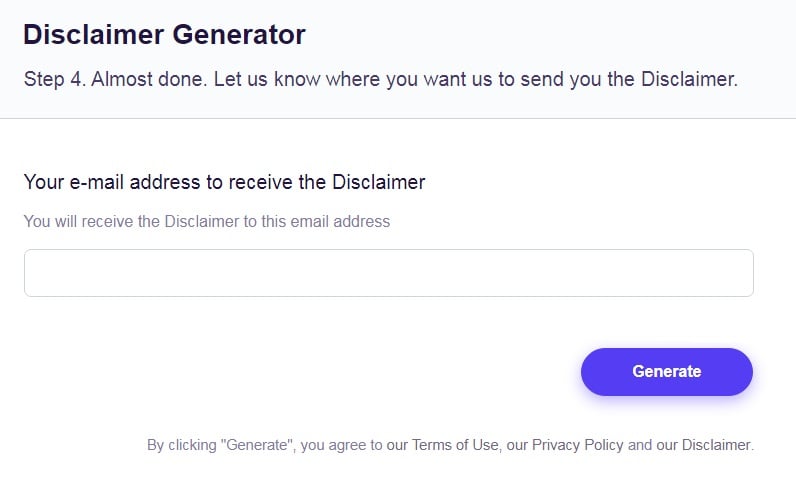
You're done! You can copy and paste your Disclaimer code into your website/app, or link to your hosted Disclaimer page.
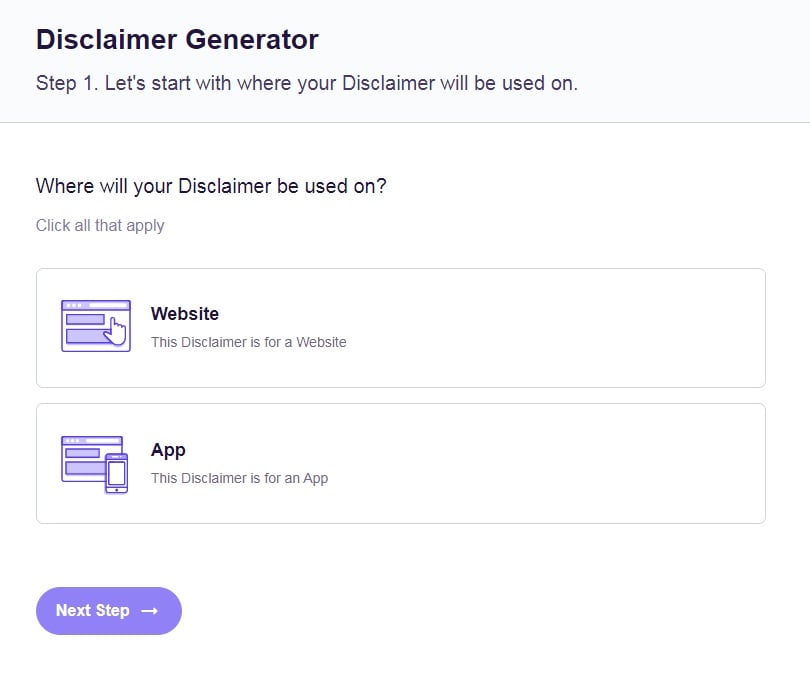
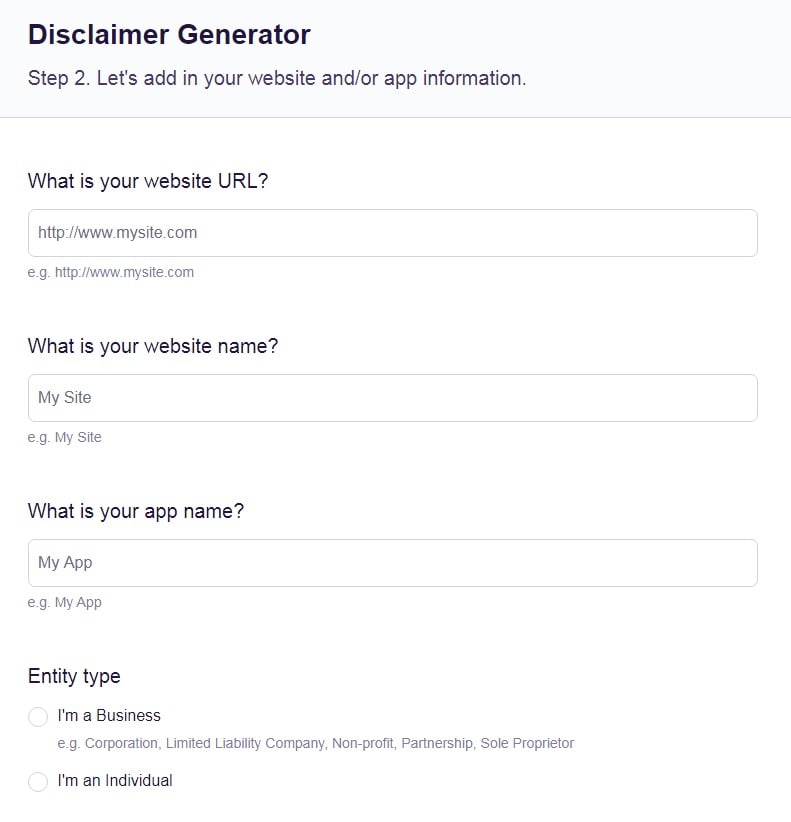
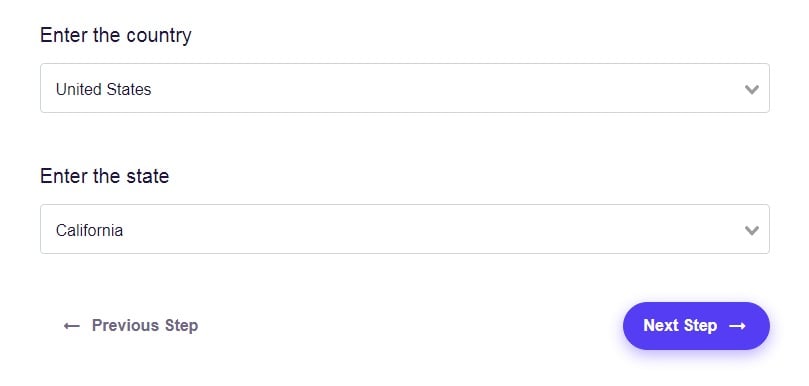
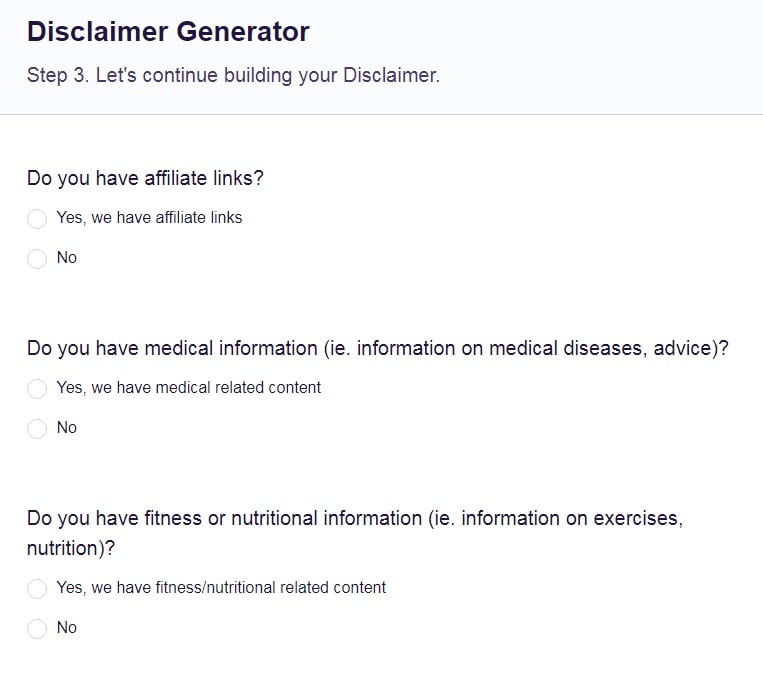
- 1. What Disclaimers Will We Cover Here?
- 2. 1. Copyright Disclaimer
- 3. 2. Fair Use Disclaimer
- 4. 3. No Responsibility Disclaimer
- 5. 4. Views Expressed Disclaimer
- 6. 5. Offensive Content Disclaimer
- 7. 6. Past Performance Disclaimer
- 8. 7. Errors and Omissions Disclaimer
- 9. 8. Affiliate Disclaimers
- 10. 9. Testimonials Disclaimer
- 11. Conclusion
What Disclaimers Will We Cover Here?
Here are the 9 kinds of disclaimers we'll look at:
- Copyright Disclaimer
- Fair Use Disclaimer
- No Responsibility Disclaimer
- Views Expressed Disclaimer
- Offensive Content Disclaimer
- Past Performance Disclaimer
- Errors and Omissions Disclaimer
- Affiliate Disclaimers
- Testimonials Disclaimer
Remember, disclaimers aren't a one-size-fits-all solution. To be effective, they need to address the holes in your content directly. Also keep in mind that disclaimers may or may not be enforceable.
Because they're so diverse and state laws vary so significantly, enforcing a disclaimer requires navigating legal complexities.
1. Copyright Disclaimer

Use a copyright disclaimer when the content on your website or app is exclusively owned by you and copyrighted by you.
Copyright disclaimers are simple and include the following components:
- Your name or business name
- Year you produced the content
- Copyright symbol
- Reservation of rights (all rights reserved, etc.)
Here's how it works:
You have a blog, and you've been publishing since 2012 and continue to publish your own material in 2018. To add a copyright, you can add the disclaimer to the bottom of your homepage with the name of your blog or business, the copyright symbol, and the years 2012-2018. The disclaimer then provides blanket copyright across all content that appears on your site.
When you place a copyright disclaimer on your work, you're providing yourself with five rights to your work that only you can transfer. Only you have the right to:
- Create or make copies
- Create new versions
- Perform or place the work in public
- Display it
- Distribute or publish it
These rights mean that anyone who adapts, modifies, or distributes the work as their own - whether you've published it or not - has violated your copyright disclaimer.
Consider adding a copyright disclaimer in one or more of the following places:
- Website homepage
- App store listing
- Terms & Conditions
- Email footers
- Within any downloadable content
Avis offers a simple copyright disclaimer in the bottom right corner of its website.
It includes the copyright symbol, the year the copyright extends to, and the businesses full name:

The Economist is a renowned international publication that distributes material in both print and digital forms. Its copyright disclaimer is found at the bottom right-hand corner of its homepage:
![]()
The legal team at The Economist added an additional piece to its disclaimer: the rights reservation. "All rights reserved" is important here because it produces a vast amount of content including writing, graphics, and videos that could be shared, adapted, or even brazenly stolen.
2. Fair Use Disclaimer

Fair use disclaimers are critical any time you're borrowing an idea, image, sentence, or an entire resource from someone else whether it's copyrighted or not.
These disclaimers state that you understand what fair use means according to U.S. Copyright Law and that you believe your use of copyrighted materials falls within these guidelines.
By adding a fair use disclaimer, you're adding an extra layer of protection to your site in the event the original owner of the borrowed content contests your use of it.
This disclaimer will have three key parts:
- Your acknowledgement that you're using copyrighted material without the explicit or expressed permission of the owner
- Your belief that your use falls within the guidelines of Fair Use
- Cite the law - Title 17 Chapter 1, Section 107 - and add a link to it
Note: Fair use disclaimers only serve you well when you fall within the guidelines for fair use. If you're not clear where your site stands, read up on the law and guidelines here and consult your lawyer.
Here's an example from the University of Texas:
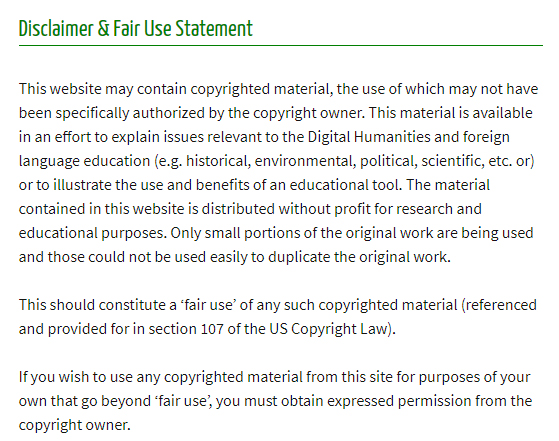
As you can see, it covers each of the basic parts:
- It acknowledges the use of copyrighted material
- It explains why the use is part of fair use
- It cites and references the law
Finally, it states that anyone who wants to use copyrighted material from the site must request permission from the copyright owner.
3. No Responsibility Disclaimer

A no responsibility disclaimer is similar to a liability disclaimer. It serves as a blanket disclaimer that says you're not responsible for what happens when someone uses your app or website.
While it's possible for a customer who feels they were wronged to blame you, the disclaimer helps protect you from damages in the event someone seeks a legal remedy.
You're not required by law to add this disclaimer, but it is helpful for fending off frivolous complaints or legal action. It does not, however, protect you from any warranty claims. If you offer a product - digital or physical - you need a separate warranty disclaimer to protect you from claims related to a product.
Here's a good example of a liability disclaimer from BCS:
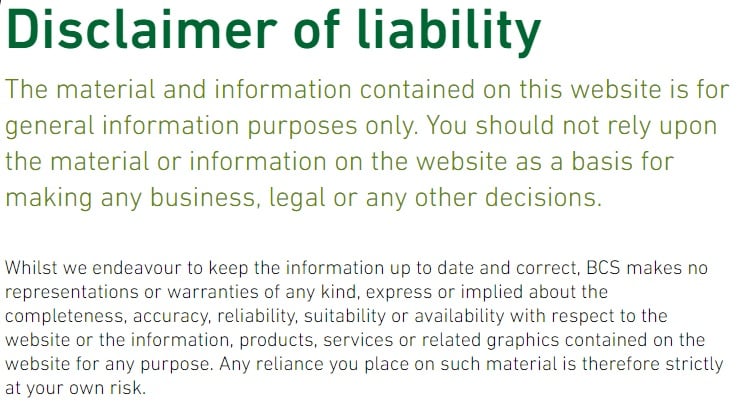
In its disclaimer of liability, BCS offers says it's not responsible for what customers do after using the site. Any decisions you make after reading a blog post or other material are your responsibility and BCS can't be held liable for anything you choose to do.
The last sentence of this excerpt is key:
Any reliance you place on such material is therefore strictly at your own risk.
It's a strong sentence, but it's important because while the previous sentences describe the ways the site may be inaccurate, the final sentence places liability squarely on the shoulders of the user.
The entire disclaimer is very long and covers a lot of bases, so check it out at the link above to get a better idea of how to write a really great disclaimer to limit your liability/responsibility.
4. Views Expressed Disclaimer

A views expressed disclaimer informs the reader that subjects, thoughts, opinions, and even presentation of facts on a page reflect only the author's views and not the wider views of the organization/company/employer/etc.
You'll want a views expressed disclaimer if you're accepting guest content or any contributions from readers - moderated or not. These disclaimers allow your contributors to submit the content they see fit - whether your organization agrees or not.
A views expressed disclaimer will protect you against backlash caused by:
- Controversial or offensive opinions
- Errors and omissions
- Incorrect (or correct) use of facts
Essentially, it allows you to tell your wider customer base, "We let them publish, but they speak for themselves - not on behalf of our business."
You'll be able to publish a wider variety of content that appeals to different consumer groups without worrying about negative associations. But these disclaimers don't just protect you from negativity or backlash, they also keep you neutral in lighter or uncontroversial content.
Both applications provide value for businesses because they allow you to publish a variety of content while allowing you to control the narrative for your app or site.
Here's an example of what the disclaimer could look like, as provided in an example by the National Institutes of Health:

Many researchers work with, for, or parallel to the NIH and because the NIH is a federal agency, it's careful to avoid looking like it advocates for certain positions. Making contributors include such a disclaimer helps accomplish that.
The NIH offers specific rules about when the disclaimer above must be used that don't often apply most websites.
Make the most of the disclaimer by adding it to any content published by an outside party. Place it in:
- Headers of guest posts
- Headers of opinion posts
- Rules of forums
- First thread on message boards
5. Offensive Content Disclaimer

An offensive content disclaimer warns visitors that they may find material on your site that is rude, lewd, or generally offensive.
You need an offensive content disclaimer if you work with any adult themes or if you allow contributions to your site. Even if you don't create the offensive content yourself, a disclaimers prevents liability in case someone else puts it on your site, i.e. through a guest post or message board. This is similar to the views expressed disclaimer.
These disclaimers are made up of two parts.
First, you need to warn the visitor that they may encounter offensive content within the realm of your site.
Second, add an agreement that informs the visitor their choice to proceed is viewed as an agreement of accountability. If they proceed past the message, then they alone are accountable for how they react to the content they find.
A disclaimer won't protect you from content that violates the law like hate speech. However, it does allow you to distance yourself from whatever is on your site but isn't directly under your purview.
Here's an example from Tackle Bullying:

In it's offensive content disclaimer, Tackle Bullying warns the user that offensive and objectionable content may exist on the site. It also indemnifies the site in the event that seriously challenging content does appear. The site also explicitly states that the material found offensive may be in violation of the sites policies and guidelines, which further serves to disassociate Tackle Bullying from offensive content.
Tackle Bullying goes one step further than many disclaimers by also encouraging users to report content they find offensive. However, it's not a free for all. Users have to provide a reason for reporting the material.
6. Past Performance Disclaimer

You should use one of these disclaimers whenever you're working in an area with a degree of risk. In most cases, they're used on financial sites related to trading, investing, and banking.
A past performance disclaimer is one of the simplest disclaimers to add because it only requires a short statement:
"Past performance doesn't guarantee future results."
If you're regulated by the SEC, then SEC Rule 156 requires you to tell investors explicitly not to rely on past investment results for future performance.
They're rarely required on general sites or apps. However, if you're trading in advice or consulting in any area, it's worth adding the disclaimer.
Here's an example from Maple Leaf Funds:

Maple Leaf Funds starts the disclaimer with the standard "Past performance does not guarantee future results."
The company goes a bit further to note why past performance shouldn't be relied on, which serves as a more compelling reason for consumers to avoid doing so.
7. Errors and Omissions Disclaimer

Errors and omissions disclaimers limit your liability in the event your information is wrong or is missing something key that changes the meaning or outcome of what you're trying to convey.
These disclaimers are commonly used by companies that disclose or discuss data, particularly data that changes regularly.
It essentially says that you're not responsible for updating your content or for making sure it's complete.
Here's an example from PwC:
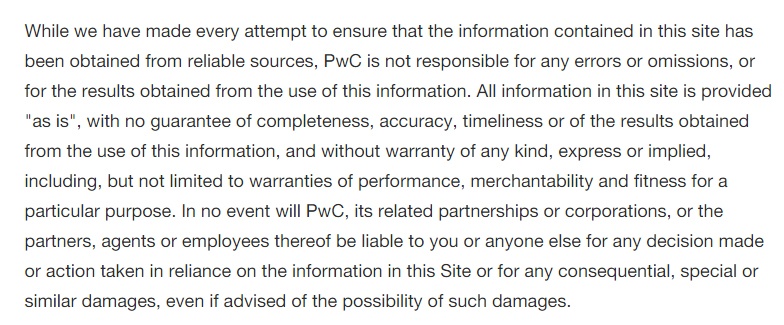
8. Affiliate Disclaimers

Affiliate disclaimers are required by both the FTC and most reputable affiliate programs, including Amazon.
These disclaimers are simple but need to follow certain guidelines. These guidelines are long-winded in nature, but they can be best summed up with the word "unambiguous."
If you want to be compliant with both program rules and Federal Trade Commission requirements, your disclaimer needs to clearly state that you're participating in an affiliate program and make money as a result of your participation.
It also needs to be conspicuously placed where any reasonable visitor to your site will see it.
To cover all your bases, include an affiliate disclaimer on:
- Your website/blog homepage
- Your content that includes affiliate links
- Your Privacy Policy
- Your affiliate disclaimer page (Not required, but a nice touch to have one)
Here's what an affiliate disclaimer looks like from Wellness Mama, a popular blog:
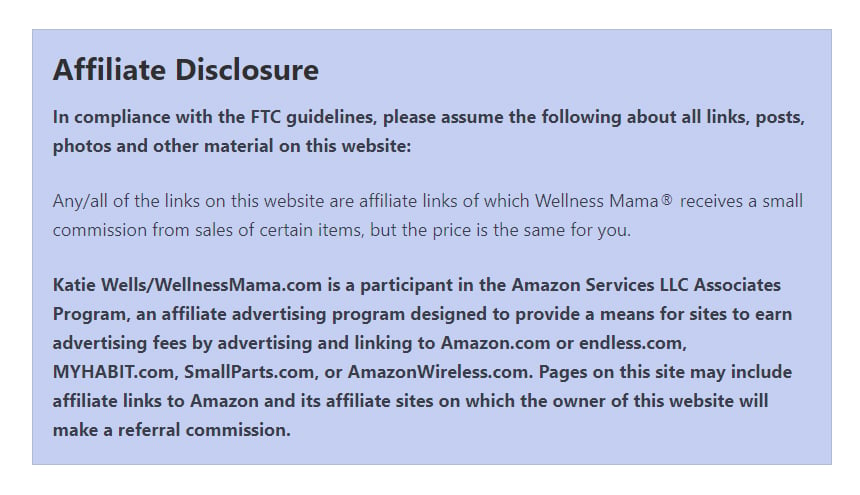
9. Testimonials Disclaimer

A testimonial disclaimer is required by the Federal Trade Commission in many cases.
Why do you need to reduce your liability when posting a rave review? Well, your disclaimer should state that not everyone is guaranteed the experience the reviewer describes. That's not to say your product, app, or site is inconsistent. Rather, not everyone will feel the same way about it.
Here's when you need to add a disclaimer:
- When you pay someone for the review
- When you exchanged a product for a review
- When you gave a discount or deal for a review
You can read more about the FTC's rules on testimonials and advertising here.
Here's an example from Financial Mentor:
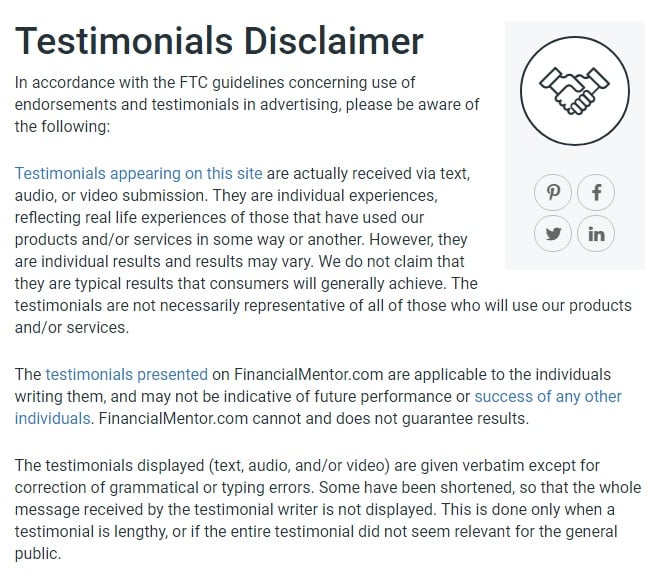
Financial Mentor's full disclaimer regarding it's testimonials covers:
- A recognition that testimonials are individual experiences
- A statement that not all customers will have the same experience
- How the testimonials are provided
Conclusion
By now, you should have recognized at least one or two disclaimers currently missing from your site. Fortunately, most disclaimers come with a basic formula that you can easily tailor to perfectly suit your own content.
As a general rule, your website or app should include a copyright disclaimer at a minimum. The rest can come as your space grows or your content changes.
Finally, remember that while disclaimers are important for shrugging off liability and preventing frivolous litigation, they don't protect you when you have legitimately done something wrong.
Keep your site in line with the law in addition to using disclaimers to enjoy the full protection they have the potential to give.
